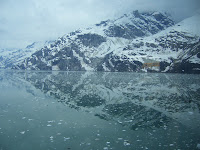Melting Icebergs Experiment


Images from personal trip to Alaska May 28 - June 4 2008
Hypothesis –
a. What will happen when the ice melts?
As the ice melts water will be displaced causing a slight overflow in the bowl. The ice will stay together because of the law of attraction.
Reflection –
a. As the ice melts, does the water overflow? Explain.
As the ice melts, the water does not overflow as I initially thought. I quickly remembered that I began the experiment with ice already formed at the basin (the bottom of the glass bowl) prior to adding water to the environment. The mass of the ice is already accounted for with the mass of the water added, and therefore the melted water just replaces the mass of the solid water (or something like that). Therefore there was no true water displacement, thereby causing the bowl of water to not overflow.
Experiment Start Time: 12:30pm on 7/10/12
OBSERVATIONS:
Ice begins as one mass of seemingly semi-attached ice cubes.
As water is added, some ice immediately float to the top of
the water. The ice that floats freely float to the top first. The ice cubes
that were initially stuck together while freezing stay at the bottom longer.
Eventually all ice cubes float to the top. Initially the ice
cubes float separately from each other. The ice cubes slowly begin to merge
toward each other as if they are attracted to each other.
The ices cubes release small air bubbles as they melt. The
cubes that are floating unattached to other cubes melt faster and stay closer
to the top of the water. The cubes that are attached to other cubes have larger
portions sinking under the water with only a portion of the attached cube
floating above the water.
As the water melts, there does not appear to be any water
displacement.
Even with no movement of the water the ice moves toward one
area of the bowl. As they move, the water moves slightly but only directly
where the ice cubes are located.
18 minutes into the experiment and there are few pieces of ice
remaining and there still does not appear to be any water displacement.
12:52 pm all ice cubes have melted. There does not appear to
be visible water displacement. There is water on the outside of the bowl that
has made it to the base of the bowl from the top.
